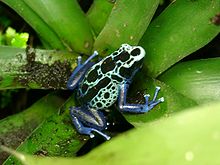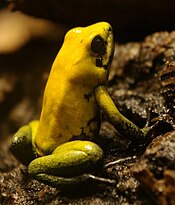Dendrobatinae: Difference between revisions
No edit summary |
Pvmoutside (talk | contribs) |
||
| (35 intermediate revisions by 28 users not shown) | |||
| Line 1: | Line 1: | ||
{{Short description|Subfamily of amphibians}} |
|||
{{Taxobox |
|||
{{automatic taxobox |
|||
| name = Dendrobatinae |
|||
| image = Färberfrosch Dendrobates tinctorius.jpg |
| image = Färberfrosch Dendrobates tinctorius.jpg |
||
| image_caption = [[Dyeing dart frog]], ''Dendrobates tinctorius''. |
|||
| image_width = 240px |
|||
| taxon = Dendrobatinae |
|||
| image_caption = [[Dyeing Poison Dart Frog]], ''[[Dendrobates tinctorius]]''. |
|||
| authority = [[Edward Drinker Cope|Cope]], 1865 |
|||
| regnum = [[Animal]]ia |
|||
| phylum = [[Chordata]] |
|||
| subphylum = [[Vertebrata]] |
|||
| classis = [[Amphibia]] |
|||
| subclassis = [[Lissamphibia]] |
|||
| ordo = [[Anura]] |
|||
| subordo = [[Neobatrachia]] |
|||
| familia = [[Dendrobatidae]] |
|||
| subfamilia = '''Dendrobatinae''' |
|||
| subfamilia_authority = |
|||
| subdivision_ranks = [[Genera]] |
| subdivision_ranks = [[Genera]] |
||
| subdivision = ''[[ |
| subdivision = ''[[Adelphobates]]''<br> |
||
''[[Andinobates]]''<br> |
|||
''[[Dendrobates]]''<br> |
|||
''[[Excidobates]]''<br> |
|||
''[[Minyobates]]''<br> |
|||
''[[Oophaga]]''<br> |
|||
''[[Phyllobates]]''<br> |
|||
''[[Ranitomeya]]'' |
|||
}} |
|||
'''Dendrobatinae''' is the main subfamily of [[frog]]s in the family [[Dendrobatidae]], the [[poison dart frog]]s of Central and South America, found from [[Nicaragua]] to the [[Amazon basin]] in [[Brazil]].<ref name=frost>{{cite web |url=http://research.amnh.org/vz/herpetology/amphibia/Amphibia/Anura/Dendrobatidae/Dendrobatinae |title=Dendrobatinae Cope, 1865 |author=Frost, Darrel R. |year=2014 |work=Amphibian Species of the World: an Online Reference. Version 6.0 |publisher=American Museum of Natural History |accessdate=13 September 2014}}</ref> |
|||
''[[Oophaga]]'' |
|||
==Description== |
|||
''[[Phyllobates]]'' |
|||
Dendrobatinae are generally small frogs; ''[[Andinobates minutus]]'' is as small as {{convert|13|-|16|mm|abbr=on}} in [[snout–vent length]]. Many species are brightly colored and all are toxic. Alkaloids in ''[[Phyllobates]]'' are particularly potent.<ref name=VittCaldwell>{{cite book|title=Herpetology: An Introductory Biology of Amphibians and Reptiles |edition=4th |first1=Laurie J.|last1= Vitt|first2=Janalee P. |last2=Caldwell|publisher=Academic Press|year=2014|pages=489–490}}</ref><ref name=AmphibiaWeb/> |
|||
All species are presumed to show [[Parental investment|parental care]], often by the male. However, some species show biparental care (''[[Ranitomeya]]''), whereas in ''[[Oophaga]]'' only females care for the [[tadpole]]s, feeding them with eggs, their only source of nutrition.<ref name=VittCaldwell/> The males are responsible for protecting the eggs from predation and keeping the eggs from drying out by urinating on them.<ref>Brust, D. G. (1993). [https://www.jstor.org/stable/1564914?seq=2 "Maternal Brood Care by Dendrobates pumilio: A Frog that Feeds its Young"], ''Journal of Herpetology''. Vol. 27, No. 1. pp. 96-98.</ref> |
|||
''[[Ranitomeya]] |
|||
}} |
|||
==General== |
|||
'''Dendrobatinae''' is the main subfamily of [[frogs]] in the [[Dendrobatidae]] family. Dendrobatinae contains the [[Poison dart frog|poison-dart frogs]] and their closest relatives. These species are all brightly colored and toxic. |
|||
There are eight<ref name=frost/><ref name=VittCaldwell/> or seven<ref name=AmphibiaWeb>{{cite web |url=http://www.amphibiaweb.org/lists/Dendrobatidae.shtml|title=Dendrobatidae |year=2014 |work=AmphibiaWeb: Information on amphibian biology and conservation. [web application] |publisher=Berkeley, California: AmphibiaWeb |accessdate=13 September 2014}} AmphibiaWeb is not placing ''Andinobates'' in any subfamily.</ref> genera in this subfamily: |
|||
{| class="wikitable" |
|||
|- |
|||
! Image !! Genus !! Living species |
|||
|- |
|||
|[[File:P.E.CRISTALINO 1.JPG|175px]] || ''[[Adelphobates]]'' <small>Grant, Frost, Caldwell, Gagliardo, Haddad, Kok, Means, Noonan, Schargel, and Wheeler, 2006</small> || |
|||
*''[[Adelphobates castaneoticus]]'' <small>(Caldwell and Myers, 1990)</small> |
|||
*''[[Adelphobates galactonotus]]'' <small>(Steindachner, 1864)</small> |
|||
*''[[Adelphobates quinquevittatus]]'' <small>(Steindachner, 1864)</small> |
|||
|- |
|||
|[[File:Ranitomeya dorisswansonae02.jpg|175px]] || ''[[Andinobates]]'' <small>Twomey, Brown, Amézquita, and Mejía-Vargas, 2011</small> || |
|||
*''[[Andinobates abditus]]'' <small>(Myers and Daly, 1976)</small> |
|||
*''[[Andinobates altobueyensis]]'' <small>(Silverstone, 1975)</small> |
|||
*''[[Andinobates bombetes]]'' <small>(Myers and Daly, 1980)</small> |
|||
*''[[Andinobates cassidyhornae]]'' <small>(Amézquita et al., 2013)</small> |
|||
*''[[Andinobates claudiae]]'' <small>(Jungfer, Lötters, and Jörgens, 2000)</small> |
|||
*''[[Andinobates daleswansoni]]'' <small>(Rueda-Almonacid, Rada, Sánchez-Pacheco, Velásquez-Álvarez, and Quevedo-Gil, 2006)</small> |
|||
*''[[Andinobates dorisswansonae]]'' <small>(Rueda-Almonacid, Rada, Sánchez-Pacheco, Velásquez-Álvarez, and Quevedo-Gil, 2006)</small> |
|||
*''[[Andinobates fulguritus]]'' <small>(Silverstone, 1975)</small> |
|||
*''[[Andinobates geminisae]]'' <small>(Batista et al., 2014)</small> |
|||
*''[[Andinobates minutus]]'' <small>(Shreve, 1935)</small> |
|||
*''[[Andinobates opisthomelas]]'' <small>(Boulenger, 1899)</small> |
|||
*''[[Andinobates tolimensis]]'' <small>(Bernal-Bautista, Luna-Mora, Gallego, and Quevedo-Gil, 2007)</small> |
|||
*''[[Andinobates viridis]]'' <small>(Myers and Daly, 1976)</small> |
|||
*''[[Andinobates virolinensis]]'' <small>(Ruiz-Carranza and Ramírez-Pinilla, 1992)</small> |
|||
|- |
|||
|[[File:Dendrobates auratus (Costa Rica).jpg|175px]] ||''[[Dendrobates]]'' <small>Wagler, 1830</small> || |
|||
*''[[Dendrobates auratus]]'' (Girard, 1855) – [[Green and black poison dart frog]] |
|||
*''[[Dendrobates leucomelas]]'' (Steindachner, 1864) – [[Yellow-banded poison dart frog]] |
|||
*''[[Dendrobates nubeculosus ]]''Jungfer and Böhme 2004 - [[Rockstone poison dart frog]] |
|||
*''[[Dendrobates tinctorius]]'' (Schneider, 1799) – [[Dyeing dart frog]] |
|||
*''[[Dendrobates truncatus]]'' (Cope, 1861) – [[Yellow-striped poison frog]] |
|||
|- |
|||
|[[File:Excidobatesmysteriosusbigetitel.jpg|175px]] || ''[[Excidobates]]'' <small>Twomey and Brown, 2008</small> || |
|||
*''[[Excidobates captivus]]'' <small>(Myers, 1982)</small> - Santiago poison frog, Peru and Ecuador |
|||
*''[[Excidobates condor]]'' <small>Almendáriz, Ron, and Brito M., 2012</small> - Ecuador |
|||
*''[[Excidobates mysteriosus]]'' <small>(Myers, 1982)</small> - Marañón poison frog, Peru |
|||
|- |
|||
||| ''[[Minyobates]]'' <small>Myers, 1987</small> || |
|||
*''[[Minyobates steyermarki]]'' - demonic poison frog, demonic poison-arrow frog |
|||
|- |
|||
|[[File:Strawberry dart frog.jpg|175px]] || ''[[Oophaga]]'' <small>Bauer, 1994</small> || |
|||
* ''Oophaga arborea'' <small>(Myers, Daly, and Martínez, 1984)</small> — [[Polkadot poison frog]] |
|||
* ''Oophaga granulifera'' <small>(Taylor, 1958)</small> — [[Granular poison frog]] |
|||
* ''Oophaga histrionica'' <small>(Berthold, 1845)</small> — [[Harlequin poison frog]] |
|||
* ''Oophaga lehmanni'' <small>(Myers and Daly, 1976)</small> — [[Lehmann's poison frog]] |
|||
* ''Oophaga occultator'' <small>(Myers and Daly, 1976)</small> — [[La Brea poison frog]] |
|||
* ''Oophaga pumilio'' <small>(Schmidt, 1857)</small> — [[Strawberry poison-dart frog]] |
|||
* ''Oophaga speciosa'' <small>(Schmidt, 1857)</small> — [[Splendid poison frog]] |
|||
* ''Oophaga sylvatica'' <small>(Funkhouser, 1956)</small> — [[Diablito poison frog]] |
|||
* ''Oophaga vicentei'' <small>(Jungfer, Weygoldt, and Juraske, 1996)</small> — [[Vicente's poison frog]] |
|||
|- |
|||
|[[File:Pbbicolor3.jpg|175px]] || ''[[Phyllobates]]'' <small>Duméril and Bibron, 1841</small> || |
|||
''P. lugubris'' species group |
|||
*''[[Phyllobates lugubris]]'' <small>(Schmidt, 1857)</small> |
|||
*''[[Phyllobates vittatus]]'' <small>([[Edward Drinker Cope|Cope]], 1893)</small> |
|||
''P. bicolor'' species group |
|||
*''[[Phyllobates bicolor]]'' <small>([[André Marie Constant Duméril|Duméril]] and [[Bibron]], 1841)</small> |
|||
*''[[Phyllobates aurotaenia]]'' <small>([[George Albert Boulenger|Boulenger]], 1913)</small> |
|||
*''[[Phyllobates sp. aff. aurotaenia]]'' <ref>{{cite web|url=https://translate.google.com/translate?u=http%3A%2F%2Fwww.dendrobase.de%2Findex.php%3Fgattung%3DPhyllobates%26art%3Dspez%26id%3D12220&sl=de&tl=en&hl=&ie=UTF-8|title=Google Translate|work=google.com}}</ref> |
|||
*''[[Phyllobates terribilis]]'' <small>(Myers, Daly, and Malkin, 1978)</small> |
|||
|- |
|||
|[[File:Ranitomeya amazonica.jpg|175px]] || ''[[Ranitomeya]]'' <small>Bauer, 1986</small> || |
|||
* ''[[Ranitomeya amazonica]]'' <small>(Schulte, 1999)</small> |
|||
* ''[[Ranitomeya benedicta]]'' <small>Brown, Twomey, Pepper, and Sanchez-Rodriguez, 2008</small> |
|||
* ''[[Ranitomeya cyanovittata]]'' <small>Pérez-Peña, Chávez, Twomey, and Brown, 2010</small> |
|||
* ''[[Ranitomeya defleri]]'' <small>Twomey and Brown, 2009</small> |
|||
* ''[[Ranitomeya fantastica]]'' <small>(Boulenger, 1884)</small> |
|||
* ''[[Ranitomeya flavovittata]]'' <small>(Schulte, 1999)</small> |
|||
* ''[[Ranitomeya imitator]]'' <small>(Schulte, 1986)</small> |
|||
* ''[[Ranitomeya reticulata]]'' <small>(Boulenger, 1884)</small> |
|||
* ''[[Ranitomeya sirensis]]'' <small>(Aichinger, 1991)</small> |
|||
* ''[[Ranitomeya summersi]]'' <small>Brown, Twomey, Pepper, and Sanchez-Rodriguez, 2008</small> |
|||
* ''[[Ranitomeya toraro]]'' <small>Brown, Caldwell, Twomey, Melo-Sampaio, and Souza, 2011</small> |
|||
* ''[[Ranitomeya uakarii]]'' <small>(Brown, Schulte, and Summers, 2006)</small> |
|||
* ''[[Ranitomeya vanzolinii]]'' <small>(Myers, 1982)</small> |
|||
* ''[[Ranitomeya variabilis]]'' <small>(Zimmermann and Zimmermann, 1988)</small> |
|||
* ''[[Ranitomeya ventrimaculata]]'' <small>(Shreve, 1935)</small> |
|||
* ''[[Ranitomeya yavaricola]]'' <small>Pérez-Peña, Chávez, Twomey, and Brown, 2010</small> |
|||
|- |
|||
|} |
|||
The most specious genera are ''[[Ranitomeya]]'' (16 species) and ''[[Andinobates]]'' (13 species).<ref name=frost/> ''[[Dendrobates]]'' used to be much larger but currently contains only five species, having had most of its species split off into genera erected later.<ref name=GrantEtal2006>{{cite journal |author1=Grant, T. |author2=Frost, D. R. |author3=Caldwell, J. P. |author4=Gagliardo, R. |author5=Haddad, C. F. B. |author6=Kok, P. J. R. |author7=Means, D. B. |author8=Noonan, B. P. |author9=Schargel, W. E. |author10=Wheeler, W. C. |name-list-style=amp|year=2006 |title=Phylogenetic systematics of dart-poison frogs and their relatives (Amphibia: Athesphatanura: Dendrobatidae) |journal=Bulletin of the American Museum of Natural History |volume=299 |pages=1–262 |doi=10.1206/0003-0090(2006)299[1:PSODFA]2.0.CO;2 |url=http://digitallibrary.amnh.org/dspace/bitstream/2246/5803/1/B299.pdf}}</ref> |
|||
{{Dendrobatidae-stub}} |
|||
[[Category:Poison dart frogs]] |
|||
[[Category:Frogs]] |
|||
[[Category:South America]] |
|||
==References== |
|||
[[fr:Dendrobatinae]] |
|||
{{Reflist|2}} |
|||
{{Taxonbar|from=Q1937619}} |
|||
[[Category:Poison dart frogs]] |
|||
[[Category:Taxa named by Edward Drinker Cope]] |
|||
Latest revision as of 19:17, 13 April 2023
| Dendrobatinae | |
|---|---|

| |
| Dyeing dart frog, Dendrobates tinctorius. | |
| Scientific classification | |
| Domain: | Eukaryota |
| Kingdom: | Animalia |
| Phylum: | Chordata |
| Class: | Amphibia |
| Order: | Anura |
| Family: | Dendrobatidae |
| Subfamily: | Dendrobatinae Cope, 1865 |
| Genera | |
|
Adelphobates | |
Dendrobatinae is the main subfamily of frogs in the family Dendrobatidae, the poison dart frogs of Central and South America, found from Nicaragua to the Amazon basin in Brazil.[1]
Description[edit]
Dendrobatinae are generally small frogs; Andinobates minutus is as small as 13–16 mm (0.51–0.63 in) in snout–vent length. Many species are brightly colored and all are toxic. Alkaloids in Phyllobates are particularly potent.[2][3]
All species are presumed to show parental care, often by the male. However, some species show biparental care (Ranitomeya), whereas in Oophaga only females care for the tadpoles, feeding them with eggs, their only source of nutrition.[2] The males are responsible for protecting the eggs from predation and keeping the eggs from drying out by urinating on them.[4]
General[edit]
There are eight[1][2] or seven[3] genera in this subfamily:
| Image | Genus | Living species |
|---|---|---|
 |
Adelphobates Grant, Frost, Caldwell, Gagliardo, Haddad, Kok, Means, Noonan, Schargel, and Wheeler, 2006 |
|
 |
Andinobates Twomey, Brown, Amézquita, and Mejía-Vargas, 2011 |
|
 |
Dendrobates Wagler, 1830 |
|
 |
Excidobates Twomey and Brown, 2008 |
|
| Minyobates Myers, 1987 |
| |
 |
Oophaga Bauer, 1994 |
|
 |
Phyllobates Duméril and Bibron, 1841 |
P. lugubris species group
P. bicolor species group
|
 |
Ranitomeya Bauer, 1986 |
|
The most specious genera are Ranitomeya (16 species) and Andinobates (13 species).[1] Dendrobates used to be much larger but currently contains only five species, having had most of its species split off into genera erected later.[6]
References[edit]
- ^ a b c Frost, Darrel R. (2014). "Dendrobatinae Cope, 1865". Amphibian Species of the World: an Online Reference. Version 6.0. American Museum of Natural History. Retrieved 13 September 2014.
- ^ a b c Vitt, Laurie J.; Caldwell, Janalee P. (2014). Herpetology: An Introductory Biology of Amphibians and Reptiles (4th ed.). Academic Press. pp. 489–490.
- ^ a b "Dendrobatidae". AmphibiaWeb: Information on amphibian biology and conservation. [web application]. Berkeley, California: AmphibiaWeb. 2014. Retrieved 13 September 2014. AmphibiaWeb is not placing Andinobates in any subfamily.
- ^ Brust, D. G. (1993). "Maternal Brood Care by Dendrobates pumilio: A Frog that Feeds its Young", Journal of Herpetology. Vol. 27, No. 1. pp. 96-98.
- ^ "Google Translate". google.com.
- ^ Grant, T.; Frost, D. R.; Caldwell, J. P.; Gagliardo, R.; Haddad, C. F. B.; Kok, P. J. R.; Means, D. B.; Noonan, B. P.; Schargel, W. E. & Wheeler, W. C. (2006). "Phylogenetic systematics of dart-poison frogs and their relatives (Amphibia: Athesphatanura: Dendrobatidae)" (PDF). Bulletin of the American Museum of Natural History. 299: 1–262. doi:10.1206/0003-0090(2006)299[1:PSODFA]2.0.CO;2.
